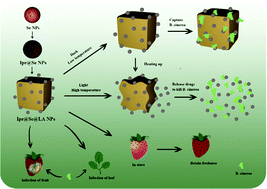A temperature-responsive selenium nanohydrogel for strawberry grey mould management†
Abstract
Grey mould is a fungal disease caused by Botrytis cinerea (B. cinerea), which can cause serious damage to a variety of crops. Herein, we developed iprodione (Ipr) reagent-loaded mesoporous selenium nanoparticles (MSe NPs), combined them with low-melting agarose (LA), and obtained a temperature-responsive selenium particle nanogel (Ipr@MSe@LA NPs) using a simple method. Importantly, Ipr@MSe@LA could capture B. cinerea and quickly be softened to realize the controlled release of Ipr, and effectively inhibit and kill B. cinerea. Plate-based antibacterial tests showed that the colony area of the Ipr@MSe@LA NPs was 4.27 cm−2, which was much smaller than that of the control (25 cm−2). In addition, the Ipr@MSe@LA NPs showed good biocompatibility, and they could improve the photosynthetic efficiency of plants and promote plant growth. Measurement of the fluorescence parameters showed that the maximum photochemical efficiency (Fv/Fm) of the plant leaves of the inoculated group (B. cinerea) is 0.58, but the Fv/Fm value of the Ipr@MSe@LA group is higher than 0.8. In particular, Ipr@MSe@LA NPs could prolong the storage time of strawberries, thereby preserving their freshness. Overall, Ipr@MSe@LA NPs exhibit excellent effects in terms of controlling strawberry gray mould and prolonging the fruit storage time, and this is expected to become a promising strategy for developing intelligent pesticide formulations.



 Please wait while we load your content...
Please wait while we load your content...